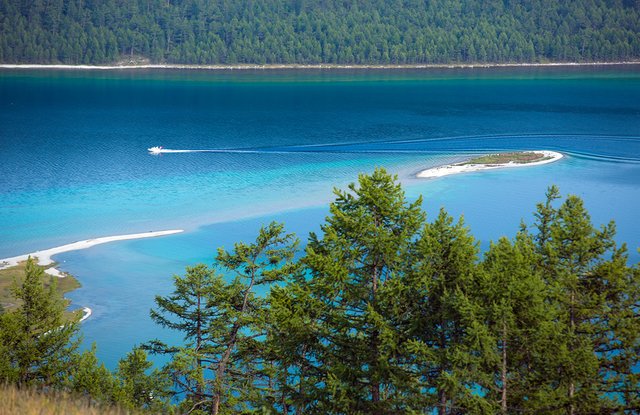Top Travel Destinations in Mongolia #4 KHUVSGUL LAKE NATIONAL PARK

In northern Mongolia, where the Central Asian Steppe meets the Siberian Taiga, Lake Huvsgul National Park preserves a place of outstanding and pristine beauty. It has long been regarded as “Blue Pearl of Mongolia” Lake Huvsgul is one of 17 ancient lakes worldwide and is variously estimated an between 2 and 5 million years old. This exceptionally pritistine lake is 136 km long, 20-40 km wide, and up to 260 m deep; it contains nearly 70% of all fresh water in Mongolia. The only outlet river Eg flows to the Selenge River, that connects Lake Baikal with Lake Huvsgul. They are sister lakes.
In 1992, this stunning landscape were set aside as Lake Huvsgul National Park.
In 2011, the whole territory of park was expanded to 1.180.270 hectares when the uppe headwaters of the Uur River were made a part of the park. In recent years, this spectacular landscape of water and mountains that is sacred to so many has become the destination of more and more travelers, from all around Mongolia and beyond.
THE ENVIRONMENT
Among 68 species of mammals, the Park is home to marmots, argali sheep, ibex, brown bear, wolf, wolverine, fox, Siberian moose, sable, roe deer, and perhaps even the snow leopard. Most of the 244 bird species visit to the park every summer, migrate long distances between their nesting grounds here and warmer winter refuges in distant countries. Because of cold winter climate dominates the park area, that is too harsh environment for most of the bird species to stay all year around in the region. Park visitors often see eagles, kites, swans, cranes, and a wide variety of ducks and songbirds.
Approximately 800 species of trees and plants have been found in the Lake Huvsgul basin.
The landscape around Lake Huvsgul region is one of jagged mountains and taiga forests.
Snow-capped peaks of two wonderful mountain ranges look down on the Lake. The Burenkhaan mountain range borders with Russia on the northern edge and contains the highest peak in the national park, called Munkh Saridag peak (3491m) in Burenkhaan Mountain range.
The Park includes the complete Lake Huvsgul basin and contains the transition zone between the Central Asian Steppe comprised of forests and grasslands and the Siberian Taiga, which is dominated by forests of larch underlain with permafrost.
Lake Huvsgul has been the home of nomadic pastoralists for thousands of years. Their lifestyles represent some of the most enduring traditions of Mongolia. Because the harsh climate, which is dominated by long and very cold winter, severly limits agriculture, semi-nomadic herding remains a dominant way of life. Herders and their animals, reindeers, sheeps, goats, cattles, yaks and horses, have long been part of the ecosistem in and around the Park.
Hundreds of Bronze-Age ritual mounds and deer stones are found throughout the region, simbolizing a cultural history that witnessed the transition from early forms of worship and sacrifice to Shamanism- an oldest religious belief on earth, strongly guided by a reverence for nature that is still practised in this remote area by Dukha-Darkhad tribe. Mongolians call as a “Tsaatan”, means “The Reindeer Herders”
The park is the one of the major domestic and popular international travel destination. Every summer thousands of long and short term travelers head towards to the Lake Huvsgul National Park.
The park offers great variety of leisure or sport activities and types of tours, that are nature sightseeing and study excursions, camping, all sorts of hiking and climbing, horse riding and trekking, biking, boating, kayaking.
Camping is increasingly popular way to enjoy and relax in the park., all camping must be located in designated campgrounds, which are established mainly along the main roads.
The park offers great variety of rewarding hiking and climbing opportunities for novice and experienced hikers, climbers and mountaineers.
Horse riding in Lake Huvsgul National Park is absolutely highlight tour of all type of travel activities here for foreign travelers.
Guided horse trips are offered and range from a few hours short rides to multi days of horse trekking to the most parts of the park and into more remote wilderness.
Travel around Lake Huvsgul on bicycle is becoming more popular each year.
Adventure-seeking visitors can rent or bring their own mountain bikes for multi-day travel in the park.
Many visitors to the National Park enjoys a ship or boat tours of the Lake.
Biggest and oldest passenger ship on Lake Huvsgul is the Sukhbaatar, that only a ferry sized vessel.
A variety of smaller boats are available for boating tours, also those boats can be rented for longer trips to islands of the lake. Kayaks are also available for rent in Hatgal, Hankh and at some ger camps around the Lake. Visitors, who does renting kayaks should pay special attention to safety messages, that provided by the experts.
Additional imformation
Back country travelers are especially urged to be self-reliant anf prefared for wilderness conditions.
Cell phone and search/rescue services are very limited. If planning a trip without a guide, get current information from rangers or commercial operators and must be certain that all appropriate safely measures and information are provided by guides and experts, who knows the wilderness environment before setting out . Guiding service in National Park’s remote area and beyond is highly reccommended.